I want to go to Hebron
After a few days in the Old City of East Jerusalem, you can see most everything it has to offer and some of the folks there even start to remember you. It’s a small place.
So it was time to venture out into the occupied West Bank, and Hebron came to mind as a place to start. This ancient city has always been a flashpoint of contention between the resident Palestinians and the Zionist settlers. I just read, in fact, where settlers had been terrorizing resident Palestinians in an attempt to get them to leave their homes in Hebron’s Old City to take their property. Can you imagine the horror of such a thing?
My friend at the overnight front desk of the Austrian Hospice where I’m residing said to catch a bus at the terminal just across the street from the Damascus Gate entrance to the Muslim Quarter, only a few minutes walk. Arriving at the appointed spot, I discovered there was no direct transport, and it was necessary to take a bus first to Bethlehem and find a connection to Hebron. The first ticket was about 7 shekels, less than a cup of coffee.
The bus to Bethlehem was a full-size charter coach, the same type of bus you find almost everywhere in the world. It was clean and decent and nearly filled with local residents. Outside the Old City, Jerusalem looked like a modern thriving metro area, though no doubt in the hands of the Israeli state with building cranes a regular feature on the bustling horizons. Were any of those new homes and businesses available to Palestinians?
There was no break or open spaces between Jerusalem and wherever it was that the bus reached the end of its line in Bethlehem. It was just another neighborhood stop 20 minutes or so from where we began. Even before I got off, some driver had me marked, and said pleasantly enough “Where do you want to go?”
“I want to go to Hebron. Where is the next bus? Are you a taxi?”
“Yes, I can take you there. And then we can go to Jericho. A lot to see there. Where in Hebron? What do you want to see?”
“The Old City. There’s no bus? How much?”
“No, there is no direct bus. Let’s go.”
I was reluctant to try another long taxi ride, but the guy looked professional and spoke well, like he had done this before. Once we agreed on a price, he claimed, “If you don’t like it, don’t pay me anything at all. I take you to the Abraham Mosque, the Old Market, you will see the settlers, and more.”
Hey, I needed a guide, and decided to get into his modern VW Golf gold taxi. We hit the road to Hebron.
You want to see the occupation?
“You want to see the occupation? Look at the settlements on both sides of the road.”
Sometimes in the distance, sometimes close to the highway were large new multilevel housing blocks of recent construction. The units close to the road all had high-security gates, several with manned IDF gunner stations. And the sheltered bus stations across the street for transport into West Jerusalem where the jobs are, my guide said the settler units were only for living quarters, had at least one heavily armed soldier walking patrol.
These modern air conditioned Zionist living quarters, considered illegal by international law, were no crappy white trash mobile homes hastily plopped down in the middle of a deserted landscape by wild-eyed Torah-inspired rogues willing to sweat out hardscrabble lives on a diet of weeds and filthy well water. These illegal Zionist settler land grabs of Palestinian territory were obvious Israeli government funded and sanctioned and protected multimillion dollar facilities now housing at least 500,000. Netanyahu’s Likud government in Tel Aviv is overseeing a continual theft of Palestinian territory rich in productive farmland and close proximity to existing infrastructure and transportation. My Palestinian driver Whalid continued to point out the impressive new settlements with a grim air of resignation.
As we neared Hebron, it was easy to see that this was a big city spread out over many kilometres, and there was some definite money and investment going on. Thank god I had gone with Whalid, and not wasted time attempting to navigate the local shuttles and walking required to arrive at the Old City located down among the winding, hilly narrow streets and byways of the occupied West Bank’s largest city of more than 200,000. I was finally in Palestine where Palestinian police and security were visible on the streets. The IDF and the interminable blue and white Israeli flags, for the moment, were nowhere in sight. Palestinian uniformed personnel and green, red and black banners and flags at long last were on full display.
We drove to the Old City where the famed Ibrahimi Mosque of Abraham, father of Judaism, Christianity and Islam, is located. But it wasn’t long before the Israeli authorities were back in our path. We had to walk through an armed checkpoint that we navigated easily because almost no one else was attempting to get through at the late morning hour. I took off my shoes and entered the mosque while Whalid waited outside.
The very spot
I overheard a tour guide referencing the infamous February 1994 murders here, and then I remembered that this was the very spot where American-Israeli settler Baruch Goldstein murdered 29 innocent Palestinians and wounded more than 100 others with an assault machine gun as they knelt and prayed. Survivors were able to overcome a uniformed Goldstein, member of the far-right Israeli Kach movement, and they beat him to death on the spot. But in the ensuing chaos, IDF soldiers reportedly fired into the panicked crowds racing to escape and shot dead at least 10 more Palestinians and injured 100 more. Reports differ as to whether Goldstein acted alone or with several others on the site. Days of rioting occurred in the aftermath with more Palestinians dead and wounded.
Inside the mosque, I saw hundreds of Palestinian school children and their teachers and guides visiting the ancient sites and entrances to subterranean caves inside. According to the wiki site, Jewish traditions found in the Hebrew Bible which are also accepted by Muslims, entombed within the Cave of the Patriarchs are the patriarchs Abraham, Isaac, and Jacob as well as three matriarchs, Sarah, Rebecca, and Leah. In addition, Jewish midrashic literature avows that Adam, the first man, and his wife, Eve, were also interred in the Cave of the Patriarchs, a tradition supported by ancient Samaritan texts.
Ever since the massacre, access to the sites within are controversially divided between Muslims and Jewish visitors by Israeli officials.
The nearby Old City marketplace had few visitors. Israeli settlers have been encroaching on Palestinian homes there for years, where they occupy much of the upper stories of the aging buildings, and in brand new housing units located behind security wire and armed guard towers. As you walk through the ground level old marketplace, one sees wire mesh completely overhead installed to catch rocks, concrete slabs and trash of all kinds rained down on the Palestinians by the settlers. My guide said the settlers also pour down human urine through the wire mesh.
The area reeked in spots like a dirty WC, but locals were busy repainting and repairing store fronts and doorways using materials supplied by the Palestinian authorities in an effort to help retain a Palestinian presence. “If they leave, the settlers will take over and move in completely,” Whalid explained.
The Israeli government-protected Zionist settlers here number an estimated less than 1,000, but a small religious community of Jews have been located in Hebron for hundreds of years who lived there in little or no conflict with Palestinians. In August 1929, scores of the Hebron religious Jews were massacred by Arab mobs who rioted in the aftermath of the infamous Zionist-Palestinian riots that began in Jerusalem.
Causes of the landmark 1929 riots are still disputed, though on-the-ground American journalist Vincent Sheean attributed the cause to wildly provocative demonstrations by Zionists in and around Jerusalem’s Western Wall, traditionally owned and controlled by Arab authorities, in an attempt to claim the renowned site at the foot of the Al-Aqsa mosque. Arab mobs reacted violently to the Zionist provocations, attacking Jews in Jerusalem and outside the city in places like Hebron in the mistaken fear the golden domed mosque itself was under attack.
On the ride back to my bus in Bethlehem, Whalid took me to the Aida refugee camp neighborhood adjacent to Beit Jala where more than 5,000 Palestinians now reside from an initial number of about 1,000 people living in tents forced from the Jerusalem and Hebron region in the wake of the state of Israel creation in 1948.
Shocked and reassured
At the Israeli separation wall, I was shocked and reassured that the Palestinian resistance remained. The hulking guard tower emplacement was completely and utterly burned from the outside. Destroyed and in danger of collapse, it appeared. I have never seen in pictures or video where a separation wall tower had been attacked and degraded like this.
What kind of immense fire had accomplished this incredible destruction? Perhaps there was still Israeli soldiers in the lookout tower; it was hard to tell if the blackening fires had destroyed the observation interior. But it looked dead and destroyed by a people who had created nearby artwork that claimed “We can’t live. So we are waiting for death.”
The surrounding grounds were dotted with garbage dumpsters, and I bought a cold soda from the woman operating a tiny convenience shop right across the street. She had to undo a series of chains that locked down her refrigerated case to retrieve my chilled Sprite. A dozen small kids crowded around, and Whalid had to give me exact change for the 3 shekels I owed because the shop lady had no change for my 10 shekel coin.
Welcome to the occupation, indeed.[]
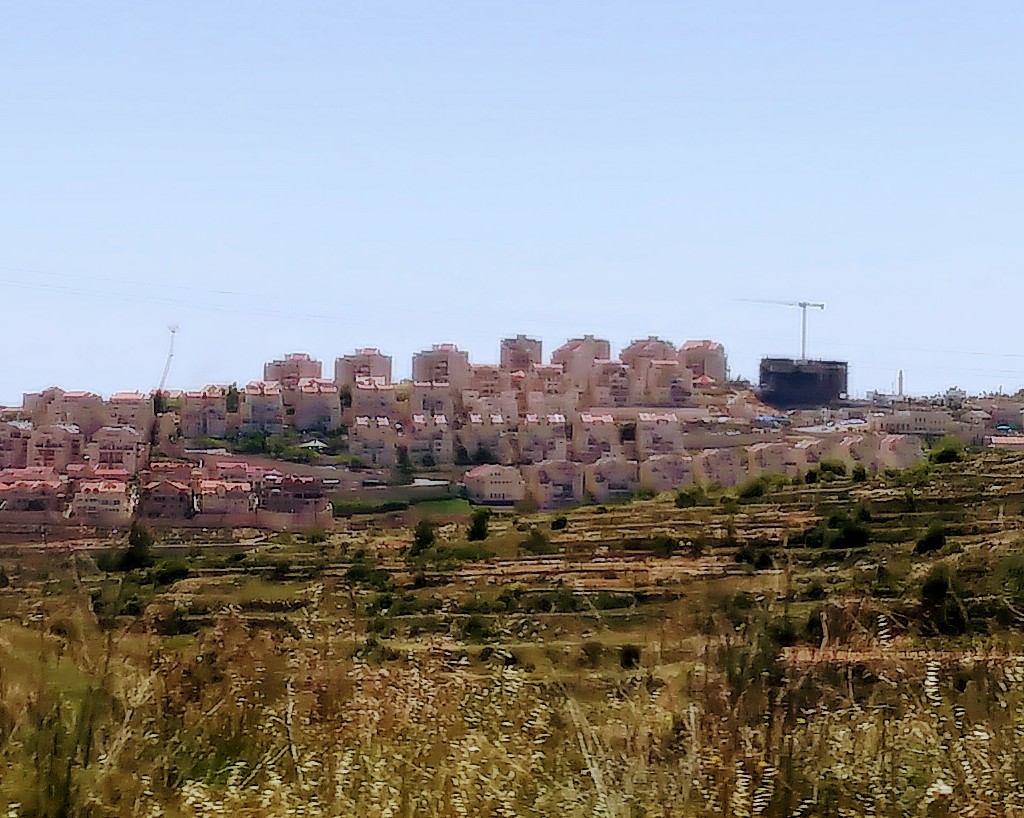 No white trash mobile homes plopped down in a deserted landscape.
No white trash mobile homes plopped down in a deserted landscape.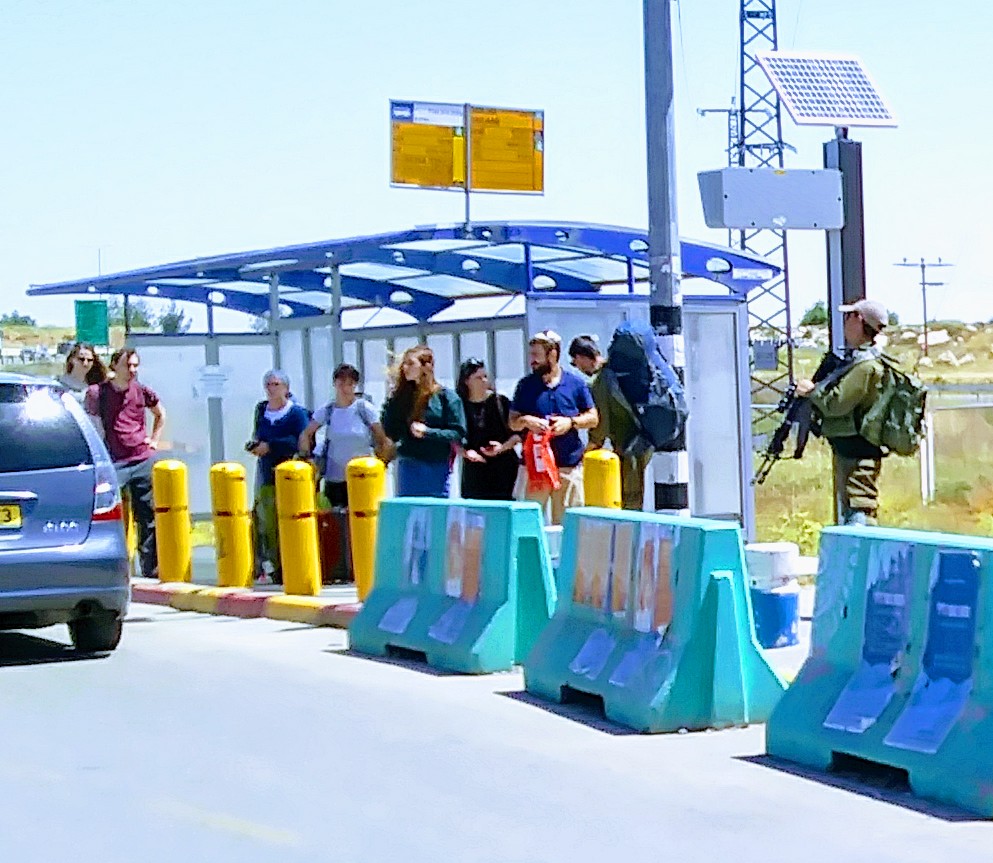 Heavily armed soldier as security for illegal Zionist resident bus shelter.
Heavily armed soldier as security for illegal Zionist resident bus shelter.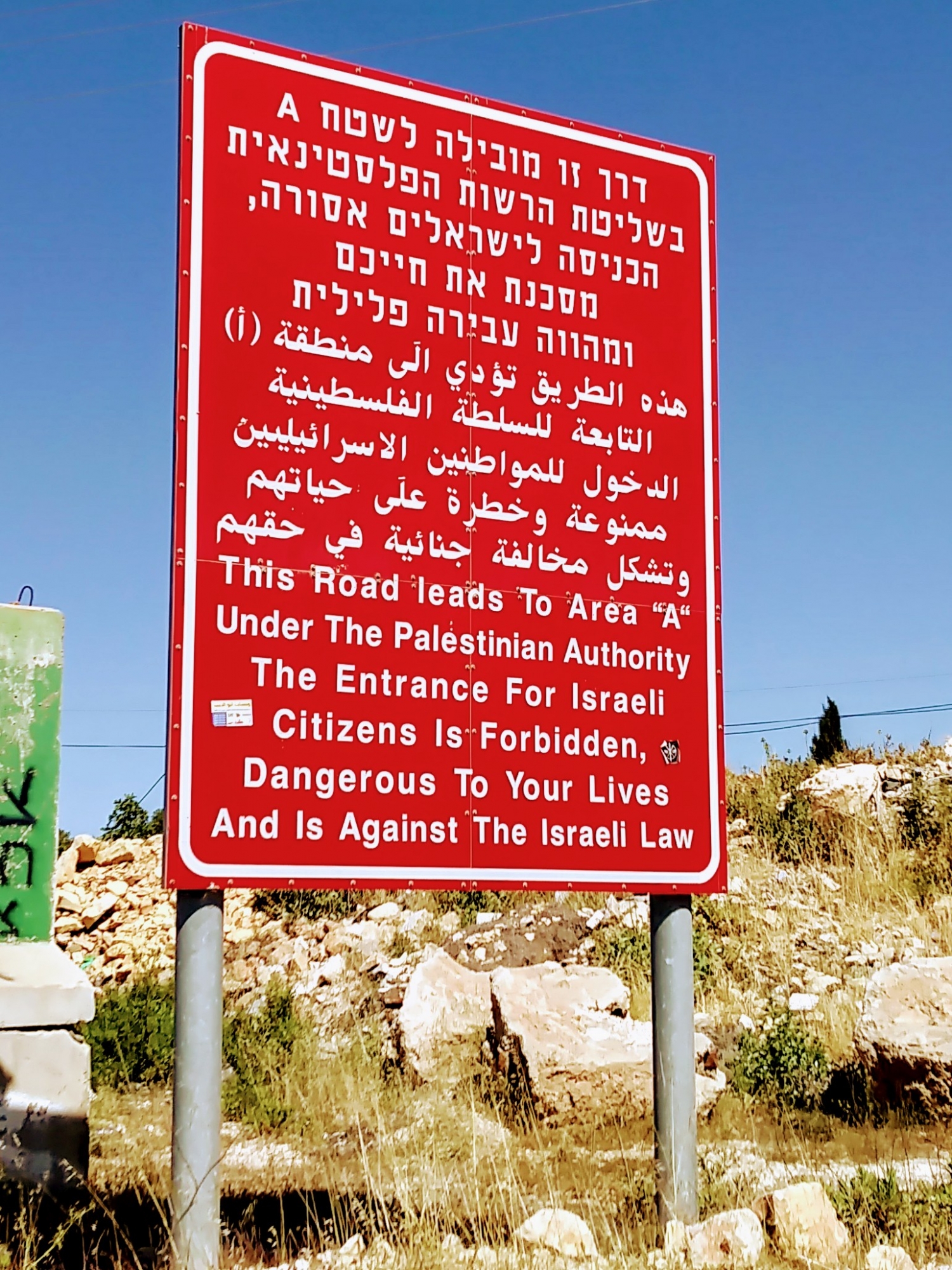 Dangerous to whose lives?
Dangerous to whose lives?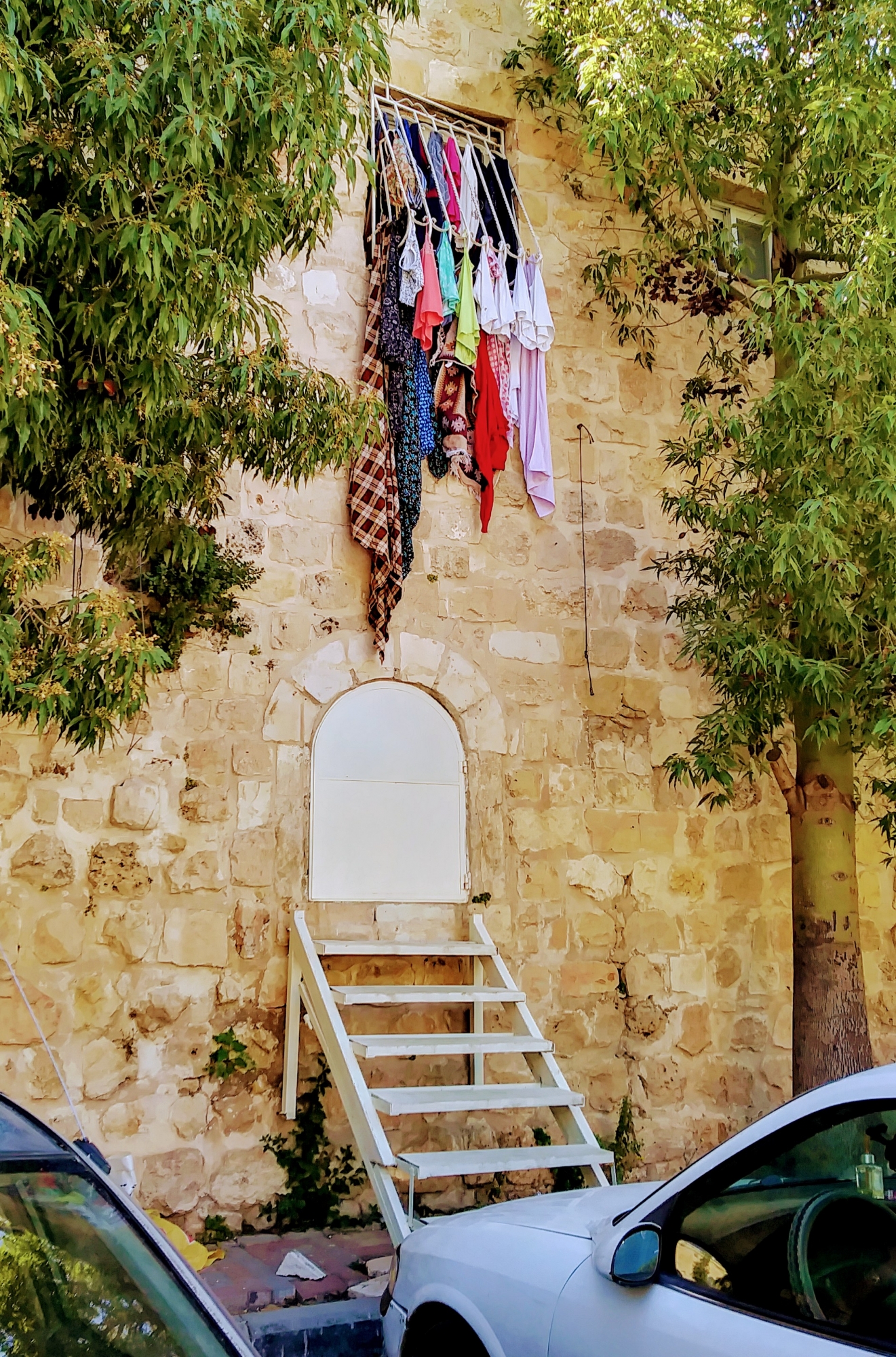 Hebron Palestinians forced to use former windows as doorways due to aggressive Zionist settlers on the other side.
Hebron Palestinians forced to use former windows as doorways due to aggressive Zionist settlers on the other side. 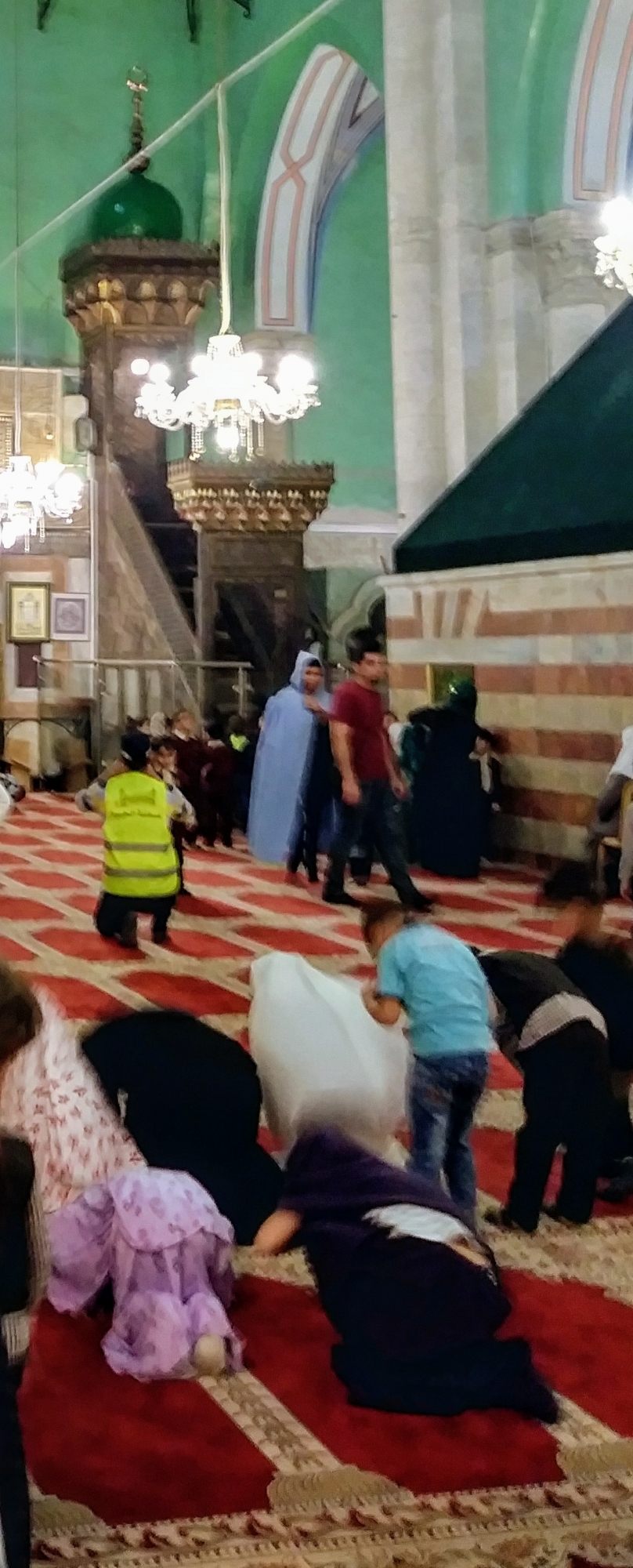 Mosque where American-Israeli settler once machine gunned innocent Muslims at prayer.
Mosque where American-Israeli settler once machine gunned innocent Muslims at prayer.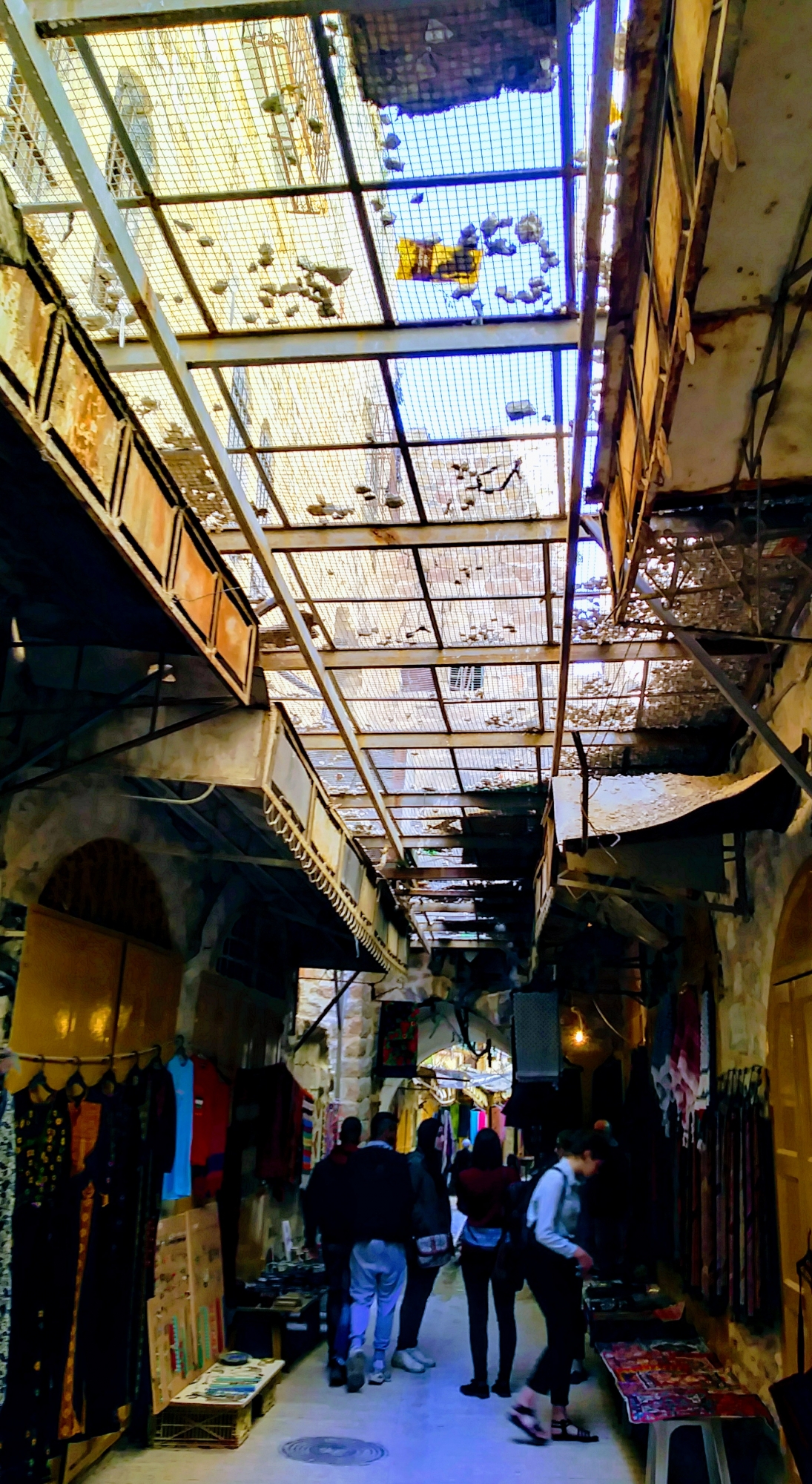 Hebron Palestinians in Old City need protective mesh from rocks & trash thrown by Zionist settlers on upper floors who also reportedly dump human waste.
Hebron Palestinians in Old City need protective mesh from rocks & trash thrown by Zionist settlers on upper floors who also reportedly dump human waste. 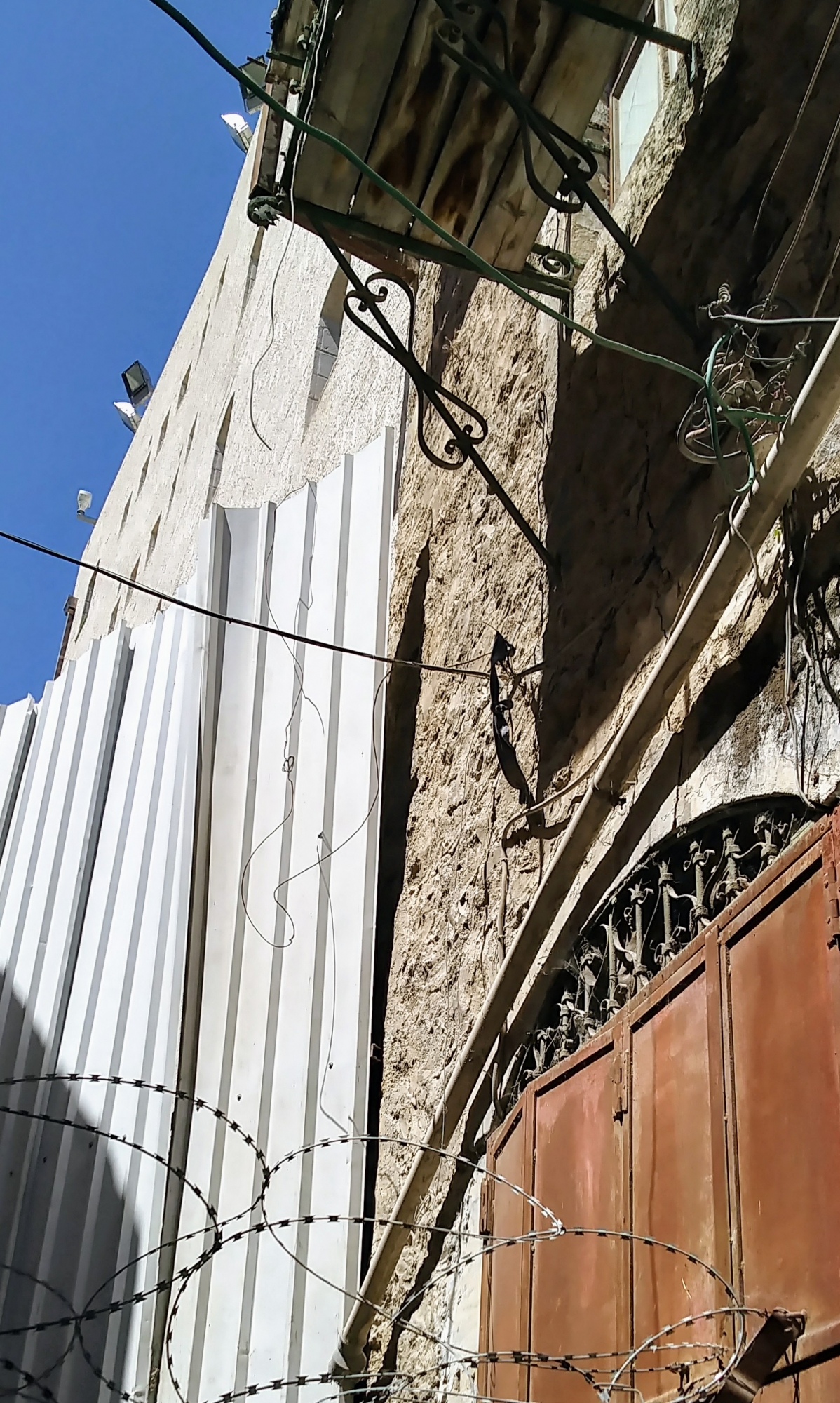 Decaying Ottoman-era Palestinian structures topped by new dystopian security-laden Zionist settlement buildings.
Decaying Ottoman-era Palestinian structures topped by new dystopian security-laden Zionist settlement buildings.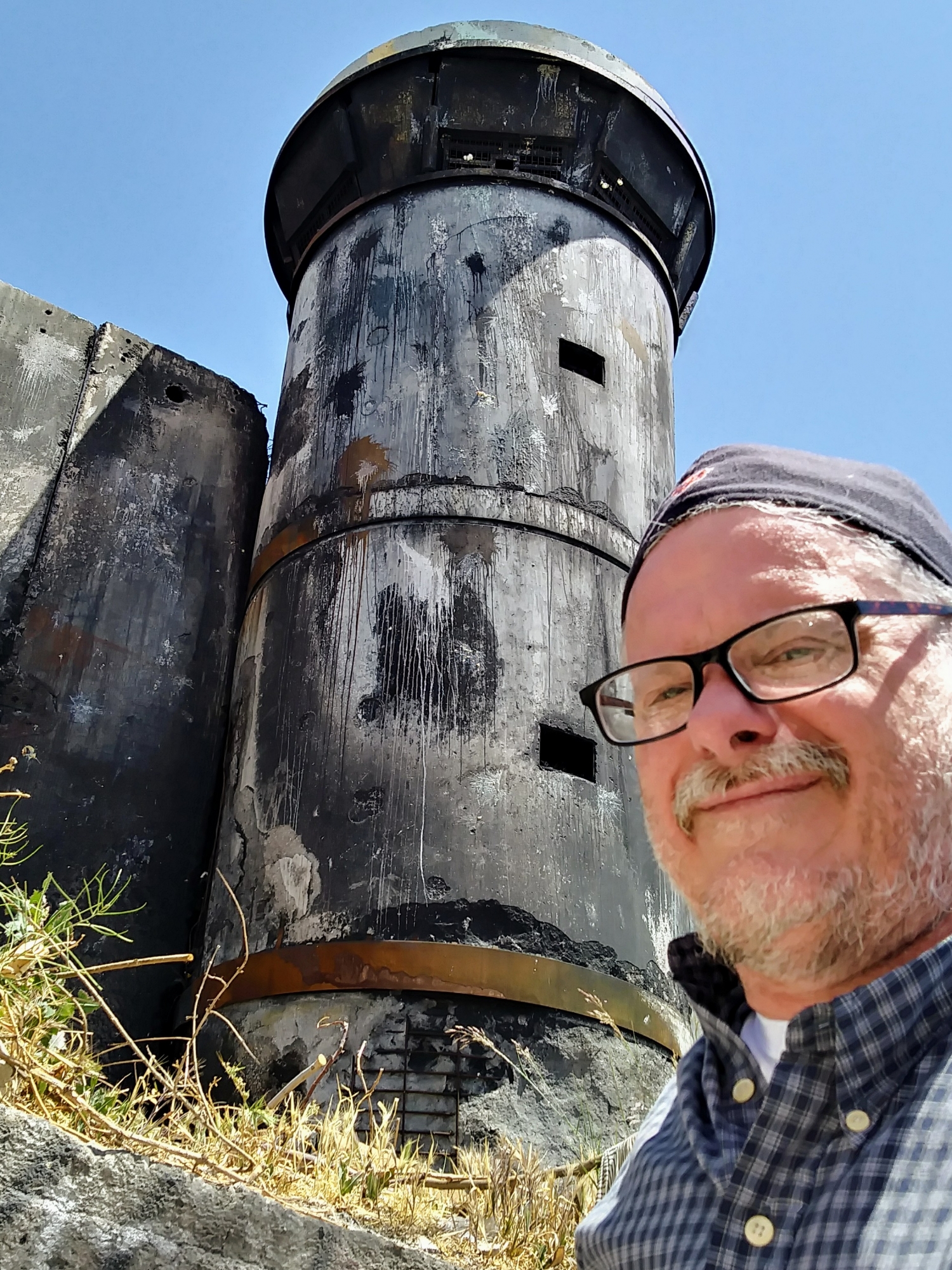 Burned out Israeli separation wall guard tower at Palestinian Camp Aida refugee district.
Burned out Israeli separation wall guard tower at Palestinian Camp Aida refugee district.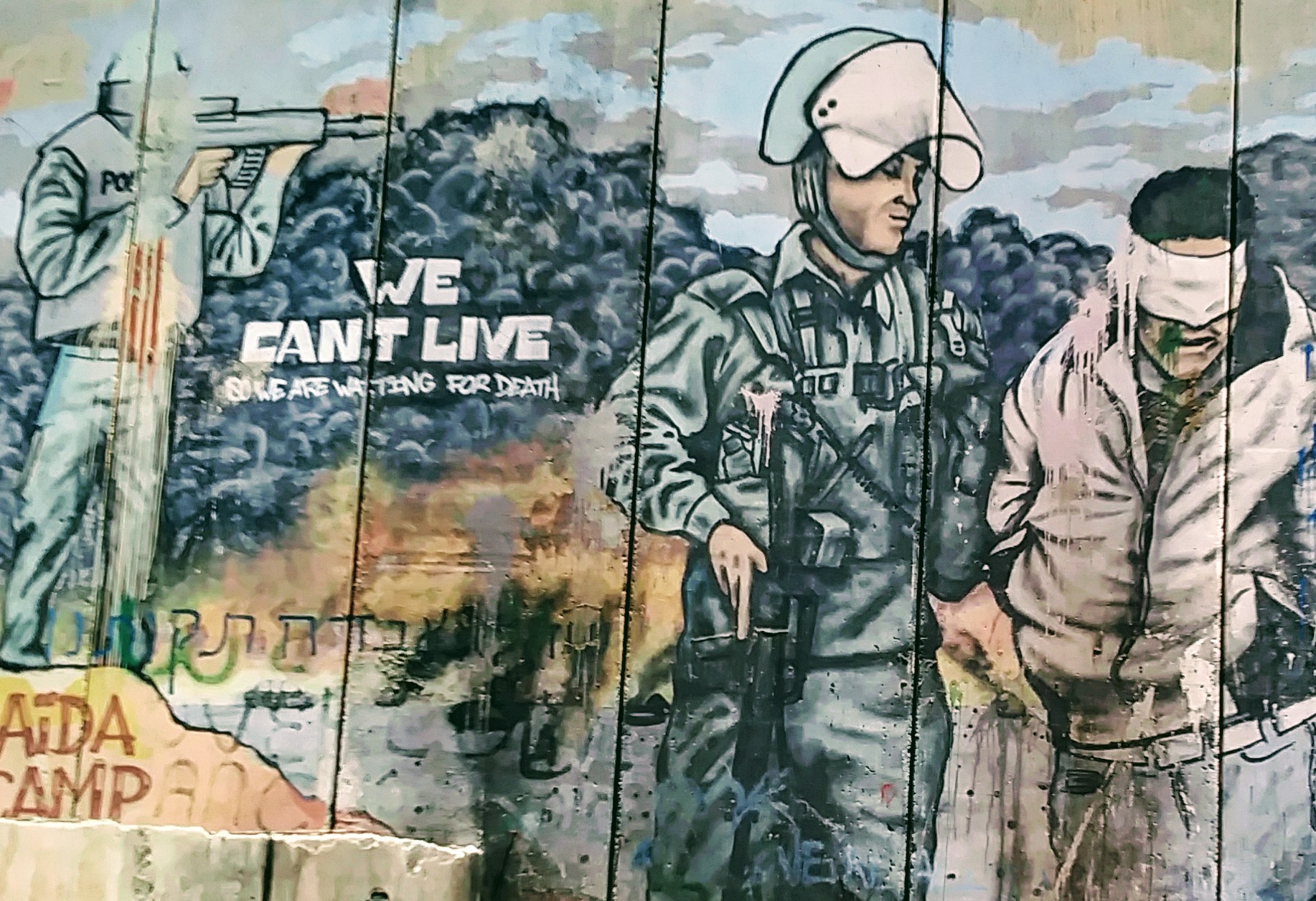 Palestinian artwork of despair on separation wall. (L. Maushard photos)
Palestinian artwork of despair on separation wall. (L. Maushard photos)

